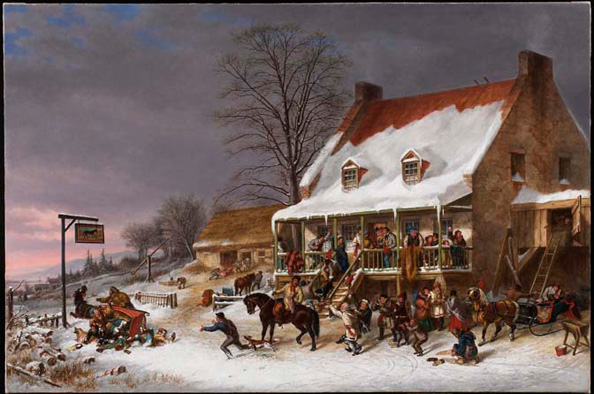
Tom Thomson - Sunset, Algonquin Park
However, this time around, we spent a lot of time in the Cornelius Krieghoff galleries. The AGO has a huge collection of Krieghoff pieces and they form an incredible record of life in the 19th century in and around Quebec. Critics would say that they are overly sentimental and many of the same themes are repeated, but we really enjoyed the details of habitant life that were portrayed in the paintings. Each one tells and elaborate story and you can spend several minutes looking closely at each one picking out the details.

Cornelius Krieghoff. Breaking up of a Country Ball in Canada, Early Morning (The Morning after a Merrymaking in Lower Canada)
Krieghoff's works are full of life and action. Sleds tip over, dogs bark, horses buck, people shout and mayhem breaks loose. There are many of these scenes of habitant life. There are also terrific paintings of the first nations peoples camping, canoeing and hunting. My favorite picture is a grand painting of the passenger steamer Quebec heading across the St. Lawrence River with Quebec in the background. It was done in about 1853 and shows Quebec without looming presence of the Chateau Frontenac which was built 40 years later.
Later on in the day, I was browsing through the news stories on Google news and came across an interesting article entitled "How They See Us" at cbc.ca about a photo exhibit now on at the Stephen Bulger gallery . It's a collection of photos of Canada sourced from collections around the world, primarily from the New York Times archive. There are some wonderful images in the article documenting Canada's history as seen through the eye of a visitor and it seemed to fit with the theme of the day - learning about early life in Canada through images. Here's a link to the "O Canada" exhibit at the Bulger Gallery.

Moose Hunting: The Return (1866), by William Notman.
Perhaps it is fitting, given our Scottish visitors, that William Notman, a prolific documenter of early Canadian life, was a transplanted Scotsman. At any rate, our next stop on the tour will be the Stephen Bulger Gallery on Queen street for a good look around at these stunning photos of Canada.